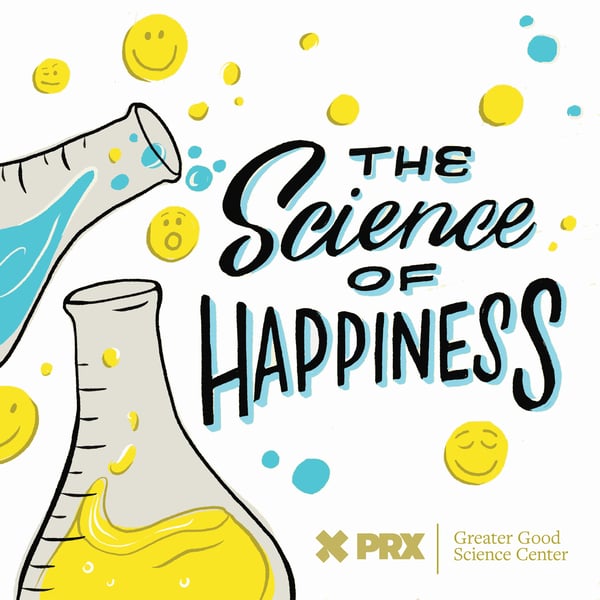5 Minutes of Progressive Muscle Relaxation, With Jo Qina'au
The Science of Happiness
PRX and Greater Good Science Center
4.4 • 1.9K Ratings
🗓️ 5 October 2023
⏱️ 12 minutes
🧾️ Download transcript
Summary
When we mindfully tense and then release our muscles, our bodies are telling our brains to relax. Try this practice that's proven to help with depression, anxiety, and stress.
Link to episode transcript: https://tinyurl.com/477t6uhv
How to Do This Practice:
Find a comfortable space to complete this practice, ideally lying down.
Soften your gaze and turn your attention towards your feet. When inhaling, tense your feet as much as you can for no more than 10 seconds. Then exhale and release your feet and toes, noticing the feelings of relaxation as you untense.
Repeat this process of tensing and releasing different parts of your body, working upwards from your legs to your torso, all the way to your upper body, arms and face. Remember to inhale when you are tensing your body, and exhale when you release.
Today’s Happiness Break host:
Jo Qina’au is meditation guide and clinical psychology fellow from Harvard University.
Learn more about Jo Qina’au’s work: https://tinyurl.com/bdfyw3ar
Follow Jo on Instagram: https://tinyurl.com/yc846waw
More resources from The Greater Good Science Center:
How to Use Your Body to Relax Your Mind (The Science of Happiness Podcast): https://tinyurl.com/mueeubr7
Five Ways Mindfulness Meditation Is Good for Your Health: https://tinyurl.com/3f79nsav
Why You Should Take a Relaxing Lunch Break: https://tinyurl.com/2p8axdba
Four Ways to Calm Your Mind in Stressful Times: https://tinyurl.com/6apdf52p
We love hearing from you! What was your experience like with this progressive muscle relaxation exercise? Email us at [email protected] or use the hashtag #happinesspod.
Find us on Spotify: https://tinyurl.com/6s39rzus
Help us share Happiness Break! Rate us and copy and share this link: https://tinyurl.com/6s39rzus
We're living through a mental health crisis. Between the stress, anxiety, depression, loneliness, burnout — we all could use a break to feel better. That's where Happiness Break comes in. In each biweekly podcast episode, instructors guide you through research-backed practices and meditations that you can do in real-time. These relaxing and uplifting practices have been shown in a lab to help you cultivate calm, compassion, connection, mindfulness, and more — what the latest science says will directly support your well-being. All in less than ten minutes. A little break in your day.
Transcript
Click on a timestamp to play from that location
| 0:00.0 | I am Dagger Keltner. Welcome to Happiness Break, the series where we take a few minutes |
| 0:09.5 | out of our day to try and practice proven to improve our well-being. Today we're trying |
| 0:14.4 | an exercise that gently works our muscles. It's called Progressive Muscle Relaxation |
| 0:19.8 | or PMR, and to do it you'll be guided through systematically tensing and then releasing |
| 0:25.8 | different muscle groups throughout your body. Studies show that Progressive Muscle Relaxation |
| 0:30.4 | helps to lower levels of stress and anxiety, improve our focus, and get better sleep. |
| 0:37.4 | Leading us in this short practice is Joe Chinaau. They're a clinical psychology fellow |
| 0:41.6 | from Harvard Medical School and a meditation guide. |
| 0:44.6 | Aloha, I'm very happy that you are joining today for Progressive Muscle Relaxation, which |
| 0:57.7 | isn't exactly a meditation. It is a kind of an exercise that involves both your mind |
| 1:06.1 | and your body, and we basically ask you to tense parts of your body as much as you can |
| 1:14.0 | without any pain, and then we ask you to release the tension, and you really get to progressively |
| 1:21.0 | go from tension to relaxation. Usually PMR is done very slowly over the course of maybe |
| 1:29.0 | 20 minutes or so, but today we are going to give you a short and sweet version just about |
| 1:35.6 | five minutes or so. It's really nice to be lying down if you can, if you can be on a bed |
| 1:43.5 | or a soft space, you know, really luxuriate and some pillows if you have them handy. If you |
| 1:50.9 | have to be seated, that's totally fine as well though. If you're doing this at your desk, |
| 1:55.0 | you can still get great benefits. So whenever you're comfortable, we'll begin to close our |
| 2:01.4 | eyes if that's okay for you. And if not, you can always leave the eyelids just slightly |
| 2:09.4 | open with the gaze nice and soft and steady on a single object. And we'll begin by drawing |
| 2:20.1 | all of our focus to the feet, noticing your feet in the air, noticing where they are in |
| 2:29.9 | space. And on your next inhale, go ahead and curl your toes and engage the feet, making |
... |
Please login to see the full transcript.
Disclaimer: The podcast and artwork embedded on this page are from PRX and Greater Good Science Center, and are the property of its owner and not affiliated with or endorsed by Tapesearch.
Generated transcripts are the property of PRX and Greater Good Science Center and are distributed freely under the Fair Use doctrine. Transcripts generated by Tapesearch are not guaranteed to be accurate.
Copyright © Tapesearch 2025.

